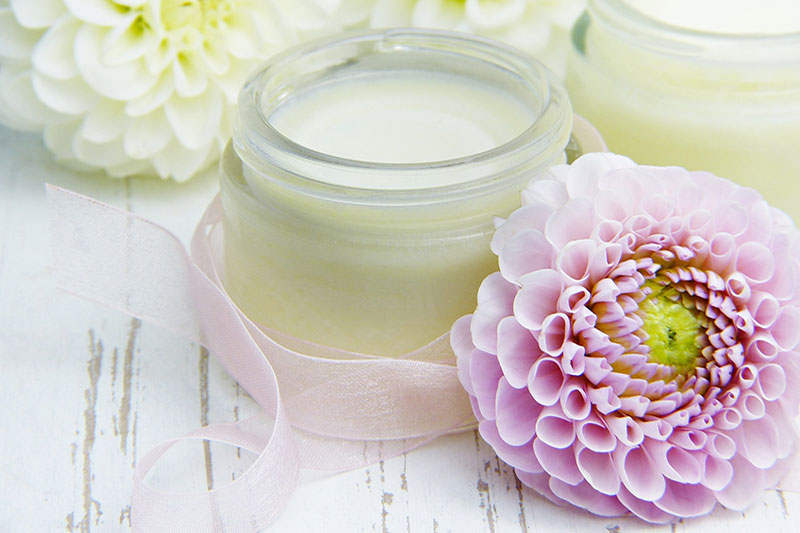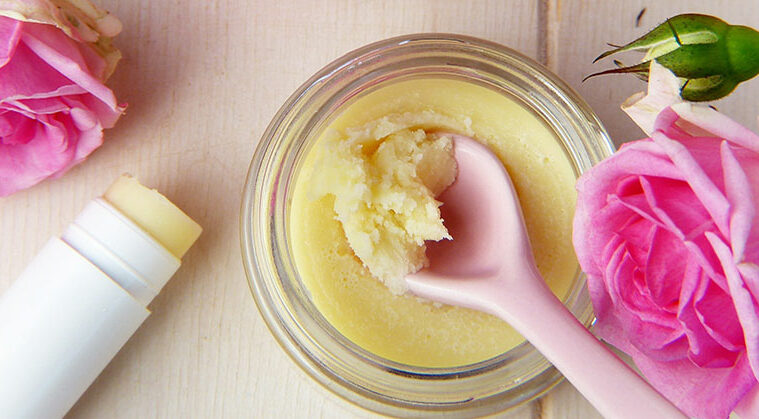How do natural body butters differ from the beauty products that grace store shelves? Oh, the differences can be astounding. So it is worth making your own beauty creams.
For too long, the beauty industry has gone unperturbed, and the masses have unknowingly been absorbing toxic products. Rather than making them more beautiful, people are unknowingly making themselves uglier. The Environmental Working group, a watch dog in the cosmetic industry standards, says the following:
“As EWG has long known — and as leading medical specialists recently underscored — many cosmetics and personal care products contain potentially toxic ingredients. Major cosmetics companies have not publicly committed themselves to removing harmful ingredients.” (1)
However, if we look to nature, we see that it furnishes humanity with a plethora of different oils. These oils are Nature’s body butters. And they serve in multi-faceted ways to truly build the best and most vegan-friendly you possible.
Body butters are practical for home use and put the “care” back into body care. Let’s discover together the benefits of the top body butters!
Natural Body Butters for DIY Beauty Products

Shea Butter – “Women’s Gold of Africa”
So perhaps you’ve already heard about this most popular of natural body butters. But do you know where it comes from? This marvelous body butter comes from the nut of the African Shea Tree, which is native to sub-Saharan Africa. (2) This costly butter, also known as “women’s gold,” provides a source of income for women in Ghana. In fact, historians speculate that even ancient Queens like Cleopatra and Sheba kept shea butter handy in their beauty cabinet. (3)
Its scientific name is a mouthful, but Butyrospermum parkii is famously known for composing “African Black Soap.” Not only is shea butter hypoallergenic, but it also prevents topical dermatitis. This is a gamechanger for those with sensitive skin.
In addition, this “mother nature conditioner” contains a relatively high amount of nonsaponifiable lipid (NSL) constituents in the fat (~5-15%), making it a viable source of the natural antioxidant vitamin E, as well as phytosterols. (4) Its fat content comes in at 60%, which is great for skin penetration, and its natural moisturizers are very similar to human skin sebum. (5)
What’s more, shea butter protects the skin from UV rays. Specifically, shea is rich in the essential fatty acids linoleic, oleic, stearic and palmitic. As an added bonus making it great for UV protection and keeping the skin soft and supple. (6) What’s more, scientific journals have found that this oil is both anti-inflammatory and anti-tumor promoting. (7)
We use Shea Butter in our homemade eczema cream!
Kokum Butter – “Indian Butter Tree”
Formally known as Garcinia indica, Kokum oil is chemically structured so that it naturally remains solid at room temperature. Its high melting point, though, causes it to melt effortlessly when applied to the skin. Its primary saturated fatty acids, stearic and oleic, come from the seed of the Indian Mangosteen fruit and allows for it to act as a powerful emollient and moisturizing vegan body butter. (8)
Native to India, it has a more naturally flaky and dry appearance, but offers a non-greasy finish for skin or hair. In fact, it has a wide variety of applications, including use for cosmetics, soaps, hair conditioners, shampoos, and lips balms. This thanks to the long shelf-life of around 1 year. (9)
Science proves that Kokum’s antioxidants (like vitamin E) helps to protect from cell damage and to aid in restoring skin elasticity. (10) You or a loved one struggling with cracked heel? Kokum has been vetted by research to be an effective healer for these kinds of skin abrasions. (11) As a skin tonic, this plant-based butter with act as a demulcent – relieving inflammation or irritation. (12) It can even serve as a cocoa butter substitute since it’s very stable structure makes it’s an ideal confectionary fat. (13) Kokum is non-comedogenic, so it won’t clog the pores. As such, it’s even suitable for skin prone to acne.

Cupuaçu Butter – “Brazilian Superstar”
A lesser-known cousin of the Cacao tree, Cupuacu (Theobroma grandiflorum) is a fruit native to the Amazonian jungle which is the actually the national fruit of Brazil. (14)
The fruit itself resembles cacao in both shape and form. And it even tastes similar to chocolate, albeit with an added tropical twist. From the 30-50 seeds within the shell, processors extract the butter by cold-pressing. (15)
And of the natural body butters, cupuacu, cousin to cacao, has a rather high fat content (nearly 60%)! (16)
Cupuacu is unique in that it has an extraordinary ability to absorb and hold water, approximately 450% its own weight, and thus, makes for a great moisturizer for topical use. (17) This water-holding capacity makes it a great alternative to the animal-derived Lanolin as a skin hydrator. Unlike some oils, this natural butter will absorb quickly into the skin and leave no residue or unpleasant odor, due to its blend of saturated fatty acids (57%) and unsaturated ones (~43%). (18) It makes for an amazing stabilizer for emulsifying oils if making a hair conditioner, and also adds to the shelf-life by making the other ingredients preserve longer. (19)
This butter is extremely rich in antioxidants, including vitamins E, A, and different B. Of the body butters, this is rising as a nature’s most rejuvenating emollient. A research study demonstrated that protein loss from hair was reduced by 35% when Cupuacu was applied to the hair post-dye treatment, thus, decreasing the typical damage done to the hair through dying. (20)

Mango Seed Butter – “Tropical Wonder”
The Mango is native to Southeast Asian countries, though it is now cultivated globally in tropical locations. Mango trees (Mangifera indica) are the largest fruit tree in the world and known most for its delectable, sweet, and juicy fruit pulp. (21) But don’t throw out the seeds! Mango seed butter is, of course, procured from the seed of the fruit. There is more than meets the eye, though. Of the total fatty acid profile, 95% comes from stearic acid, oleic acid, and palmitic acids. A nurturing combination among natural body butters. (22)
Mangoes are known for being rich in vitamins C and A, and so is the butter, thus, environmental damage is curbed by its high antioxidant content, and well as it ability to form collagen, important for skin structure. (23) In 2020, a study conducted showed that the mango kernel contained antibacterial components to fight off unwanted pathogens, which adds potential to prevent skin damaging microbes. (24)
This soothing, semi-solid butter comes to us touted as a new alternative to cacao butter. That could be because it has a similar fat content. In clinical trials, a mango-based topical solution proved more effective than the commercially-made lotion for reducing skin blemishes, for increased shelf-life and moisturizing capabilities. (25)
Looking for an oil that can hydrate, protect, and nourish your skin, as well as prevent signs of aging? Then mango would be one of the better body butters to try.



